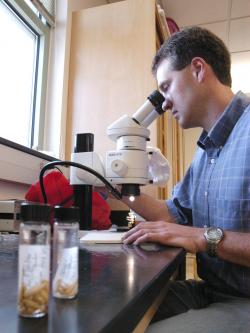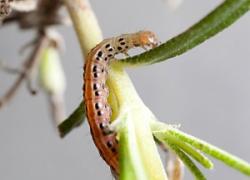Skeen Hall Research Labs
Skeen Hall is the site of most departmental bench-science; facilities were new in 2000, and are comprised of four 2,000 sq ft labs and associated special-purpose rooms; labs organized according to function, facilitating shared use of equipment; each houses 2-5 PIs from EPPWS, Plant & Environmental Sciences, and Extension Plant Sciences, along with all associated research personnel, graduate students and post-docs.
Molecular Biology Lab
The Molecular Biology Lab is equipped for sophisticated biochemical and molecular research; recently certified for BL-2 level work; major equipment includes: laminar flow hoods, incubators, -20 and -80 freezers, 96-well PCR machines, tissue grinder for 96-well plates, fluorescent gel imager, real-time quantitative PCR machine, helium-driven particle gun for biolistic plant transformation/virus inoculation, and all routine equipment for standard molecular work; associated rooms/facilities dedicated to: plant tissue culture, including sterile hoods and growth chambers; field sample processing; “hot lab” for use of radioactivity; dark room; cold rooms.
Weed Insect Biology Lab

The Weed Insect Biology Lab provides access to major equipment that includes: Li-Cor 6400 photosynthesis meter; ultra- and high-speed centrifuges; -20 and -80 freezers; spectrophotometer, fluorometer, HPLC with radiometric, single-point UV and refractive index detectors, HPLC with photodiode array detector and autosampler; fraction collector; gas chromatograph; scintillation counter; growth chamber; biological sample oxidizer; leaf area meter; pressure chamber for water potential determination; specialized facilities include: the Natural Products and Pesticide Analysis, Fate and Transport Lab which is licensed for radioisotope work; shared use of previously-described special-purpose rooms.
Plant Pathology Lab
The Plant Pathology Lab in Skeen Hall is equipped for bench research on plant viruses, fungi, and plant-parasitic nematodes; major equipment includes: ultracentrifuge; tabletop centrifuges; microfuges; 2 PCR thermal cyclers; -20 and -80 freezers; lyophylizer for fungal specimens; laminar flow hoods; biosafety cabinet; many incubators; 3 growth chambers; pressure plate extractor; several high-quality microscopes; all routine equipment for standard molecular biology work; pH and EC meters; data loggers. Specialized facilities include shared separate rooms for: rearing and manipulating insects; working with soil and field samples; use of previously-described special-purpose rooms.
Integrated Pest Management Lab
The Integrated Pest Management Lab is equipped for bench research on insects, pesticide toxicology, and extension plant pathology diagnostics; major equipment includes: incubators, -20 freezers, refrigerators, walk-in cold room, dissecting and compound microscopes, biosafety cabinet, HPLC, Nikon digital imaging system.
High Containment Insect Facility (Quarantine Lab)
The Quarantine Lab as the high containment research center for exotic insect- and weed-feeding arthropods in the southwestern United States, this facility enables the introduction, testing, and dissemination of arthropods for control of weeds and pest insects. Phytophagous and insectivorous arthropods are imported from cooperators at USDA, other universities, and international labs in Asia, Australia, Canada, South America, and Europe. Specific functions of the facility include: verifying identification of biological control agents; holding and rearing biological control agents; conducting host specificity studies; screening for undesirable organisms, including pest insects, parasites, parasitoids, entomopathogens, plant pathogens, and noxious weed seeds or other vegetative material. When an arthropod is cleared for release by Federal and State agencies, it is distributed to entomologists and weed scientists throughout the United States for further study and field release. The facility consists of: a main 3,200 sq ft high-containment laboratory, including four 95 sq ft temperature and humidity controlled rearing rooms, three additional 95 sq ft temperature controlled rearing rooms, a 95 sq ft walk-in cooler, and 175 sq ft clean room for genetic analysis; 800 sq ft high-containment greenhouse; 300 sq ft head house. Dedicated equipment that must remain in quarantine include: pass-through autoclave; microscopes; 3 digitally-controlled incubators; PCR thermal cycler and all equipment and supplies needed for DNA isolation and molecular characterization of arthropods.
Arthropod Museum

The Arthropod Museum is a 900 sq ft facility that offices the PI, full-time temporary collections manager, graduate and undergraduate student employees, and houses: pinned specimen cabinets (22 research; 5 teaching and outreach); four alcohol specimen cabinets; databasing computers; microscopes; 500-volume library and a collection of over 3,000 pertinent reprints.
GIS and Remote Sensing Lab
The GIS and Remote Sensing Lab is a 600 sq ft laboratory that supports research on precision technologies; equipped to collect spectral reflectance data in the field; facility has been receiving and archiving real-time satellite data from the following satellites and satellite systems:
- NOAA-12, -14, -15, -16, -17
- DMSP-10, -11, -12, -13, -14, -15
- GOES-08, -10, -12
- ORBVIEW-2 (SeaWiFS)
We also receive MODIS data from NASA TERRA and AQUA via subscription service from NASA and via OSU's Direct Broadcast capability.
Major equipment includes: Computers and servers for processing aerial and satellite data; ASD FieldSpec Pro Spectroradiometer capable of measuring spectral reflectance in the range 350-2500 nm; Cessna 180 single-engine fixed-wing aircraft that can be used for aerial photography; 6 handheld Trimble Explorer GPS receivers; Duncan Tech digital color Infra-red video camera; ENVI, ERDAS Imagine, and ARC GIS software.